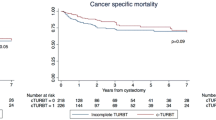Abstract
Introduction
We evaluate the incidence and risk factors associated with positive soft tissue surgical margins (STSM) and determine the association with various surgical and pathological characteristics and clinical outcomes in patients undergoing radical cystectomy (RC) for bladder cancer.
Patients and methods
From November 1971 to December 2005, 1,591 patients with primary transitional cell carcinoma (TCC) of the bladder underwent RC, with an extended bilateral pelvic lymphadenectomy and urinary diversion. A positive STSM was defined as tumor identified at the inked perivesical soft tissue surrounding the cystectomy specimen. Data were analyzed according to various clinical and pathologic variables, and survival analysis was performed.
Results
A total of 18 patients (1%) demonstrated pathologic evidence of a positive STSM following RC. Positive STSM were significantly associated with lymphovascular invasion, advanced pathologic stage, lymph node involvement, extent of nodal involvement and lymph node density. No patient with an organ-confined primary bladder tumor had a positive STSM, while 3% with extravesical tumor extension demonstrated a positive STSM. Recurrence-free and overall survival at 5 and 10 years for patients with a positive STSM was 29 and 22%, and 29 and 11%, respectively (p < 0.001). A positive STSM increased the risk of recurrence by threefold and the overall risk of death by 2.6 times. Only nine patients (1%) without evidence of nodal involvement had a positive STSM with a worse survival compared to those same pathologic subgroup and negative STSM. Nine patients (2%) with lymph node tumor involvement had positive STSM and also demonstrated significantly worse survival.
Conclusion
Although a positive STSM was present in only 1% of patients undergoing a RC for TCC of the bladder, it was found to be an independent risk factor for advanced disease, lymph node involvement and tumor progression with worse survival. A dedicated effort should be made to avoid a positive STSM at the time of RC.
Similar content being viewed by others
References
Stein JP, Lieskovsky G, Cote R, Groshen S, Feng AC, Boyd S et al (2001) Radical cystectomy in the treatment of invasive bladder cancer: long term results in 1,054 patients. J Clin Oncol 19:666
Madersbacher S, Hochreiter W, Burkhard F, Thalmann GN, Danuser H, Markwalder R et al (2003) Radical cystectomy for bladder cancer today—a homogeneous series without neoadjuvant therapy. J Clin Oncol 21:690. doi:10.1200/JCO.2003.05.101
Stein JP, Skinner DG (2003) Results with radical cystectomy for treating bladder cancer: a ‘reference standard’ for high-grade, invasive bladder cancer. BJU Int 92:12. doi:10.1046/j.1464-410X.2003.04274.x
Hautmann RE, Gschwend JE, de Petriconi RC, Kron M, Volkmer BG (2006) Cystectomy for transitional cell carcinoma of the bladder: results of a surgery only series in the neobladder era. J Urol 176:486. doi:10.1016/j.juro.2006.03.038
Herr HW, Faulkner JR, Grossman B, Natale RB, deVere White R, Sarosdy MF, Crawford ED (2004) Surgical factors influence bladder cancer outcomes: a cooperative group report. J Clin Oncol 22:2781. doi:10.1200/JCO.2004.11.024
Stein JP (2006) Improving outcomes with radical cystectomy for high-grade invasive bladder cancer. World J Urol 24:509. doi:10.1007/s00345-006-0111-1
Stein JP, Skinner DG (2006) Radical cystectomy for invasive bladder cancer: long-term results of a standard procedure. World J Urol 24:296. doi:10.1007/s00345-006-0061-7
Dotan ZA, Kavanagh K, Yossepowitch O, Kaag M, Olgac S, Donat M, Herr HW (2007) Positive surgical margins in soft tissue following radical cystectomy for bladder cancer and cancer specific survival. J Urol 178:2308. doi:10.1016/j.juro.2007.08.023
Bergkvist A, Ljungqvist A, Moberger G (1965) Classification of bladder tumors based on cellular pattern. Preliminary report of a clinical-pathological study of 300 cases with a minimum follow-up of eight years. Acta Chir Scand 130:371
Fleming ID, Cooper JS, Hensen DE, Hutter RVP, Kennedy BJ, Murphy GP et al (1997) AJCC cancer staging manual, 5th edn. Lippincott, Philadelphia, pp 241–243
Kaplan EL, Meier P (1958) Nonparametric estimation from incomplete observations. J Am Stat Assoc 53:457. doi:10.2307/2281868
Miller RG (1981) Survival analysis. Wiley, New York, pp 114–118
Breslow N (1988) Comparison of survival curves. Oxford University Press, Oxford, pp 398–403
Skinner EC, Stein JP, Skinner DG (2007) Surgical benchmarks for the treatment of invasive bladder cancer. Urol Oncol 25:66. doi:10.1016/j.urolonc.2006.05.010
Cheng L, Weaver AL, Leibovich BC, Ramna ni DM, Neumann RM, Scherer BG et al (2000) Predicting the survival of bladder carcinoma patients treated with radical cystectomy. Cancer 88:2326. doi:10.1002/(SICI)1097-0142(20000515)88:10<2326::AID-CNCR17>3.0.CO;2-T
Herr H, Lee C, Chang S, Lerner S (2004) Standardization of radical cystectomy and pelvic lymph node dissection for bladder cancer: a collaborative group report. J Urol 171:1823. doi:10.1097/01.ju.0000120289.78049.0e
Herr HW, Faulkner JR, Grossman HB, Crawford ED (2004) Pathologic evaluation of radical cystectomy specimens: a cooperative group report. Cancer 100:2470. doi:10.1002/cncr.20282
Sternberg CN, Donat SM, Bellmunt J, Millikan RE, Stadler W, De Mulder P et al (2007) Chemotherapy for bladder cancer: treatment guidelines for neoadjuvant chemotherapy, bladder preservation, adjuvant chemotherapy, and metastatic cancer. Urology 69:62. doi:10.1016/j.urology.2006.10.041
Grossman HB, Natale RB, Tangen CM, Speights VO, Vogelzang NJ, Trump DL et al (2003) Neoadjuvant chemotherapy plus cystectomy compared with cystectomy alone for locally advanced bladder cancer. N Engl J Med 349:859. doi:10.1056/NEJMoa022148
Conflict of interest statement
There is no conflict of interest.
Author information
Authors and Affiliations
Corresponding author
Rights and permissions
About this article
Cite this article
Hadjizacharia, P., Stein, J.P., Cai, J. et al. The impact of positive soft tissue surgical margins following radical cystectomy for high-grade, invasive bladder cancer. World J Urol 27, 33–38 (2009). https://doi.org/10.1007/s00345-008-0345-1
Received:
Accepted:
Published:
Issue Date:
DOI: https://doi.org/10.1007/s00345-008-0345-1




